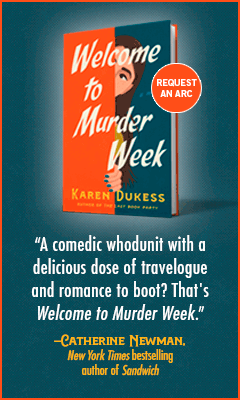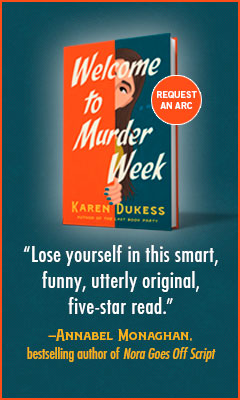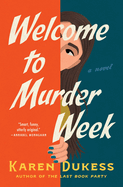Welcome to Murder Week
by Karen Dukess
In her warm, witty second novel, Welcome to Murder Week, Karen Dukess (The Last Book Party) combines a fake murder mystery (set in a picture-perfect English village) with murkier questions of family history and identity. Dukess's protagonist, risk-averse Cath Little, joins two fellow Americans in an entertaining quest to solve a fictitious murder while digging for answers about her mother's past.
Comfortably rooted in Buffalo, N.Y., Cath is (mostly) happy working as an optician, running the business she's inherited from kindhearted Mr. Groberg, a mentor and surrogate grandfather. But as she's sorting through papers after her mercurial mother's death, Cath discovers her mother, Skye, had booked a surprise trip for the two of them to visit Willowthrop, a charming English village in the Peak District, and take part in a murder mystery game put on by the locals. Cath doesn't want to go, but her ticket is nonrefundable, and Mr. Groberg employs a perfect metaphor to nudge her forward: travel, he points out, can be as clarifying as getting new glasses, making everything old now new. Though Cath is skeptical, she takes the leap, hoping the trip at least will offer some closure regarding her mother's death.
When Cath arrives in Willowthrop, she's charmed by the pastoral landscape and relieved to hit it off with her two roommates: Amity, a cheery romance novelist searching for fresh inspiration in writing and life, and Wyatt, who adores his husband, Bernard, but is restless and bored working in Bernard's birding shop. Together, the unlikely American trio dives into the game with gusto, but they keep turning up odd coincidences tying Cath's mother to Willowthrop. Although Cath wants to focus on the mystery (who "killed" gossipy hairdresser Tracy Penny, and why?), she can't ignore the growing sense that her mother booked this trip to this particular village for a reason.
Dukess's narrative deftly combines classic murder-mystery elements--including a few delightful twists on stock characters--with Cath's quest for information about Skye's past. The villagers of Willowthrop, acting in roles for the game, include several English stereotypes: the village busybody, the aristocratic horsewoman, the officious constable. (While the actors generally stick to their roles, there are a few hilarious character-breaking moments, including supposedly dead Tracy whispering a plug for her organic hair products). But Cath soon encounters one man who appears genuine: Dev Sharma, a handsome local bartender with alluring dark eyes and a knack for distilling artisanal gin. As Cath and her teammates prowl around the village in search of clues, she makes time to drop by Dev's bar, wondering if this unlikely trip will help open her closed-off heart.
While the details (and humor) of Willowthrop's murder plot will doubtless appeal to fans of Agatha Christie and Midsomer Murders, the novel's depth goes far beyond a whimsical murder-solving romp. Cath is forced to confront her long-held feelings of abandonment and the questions left unresolved by Skye's death. Dukess layers themes of motherhood, identity, and abandonment even in the murder plot, drawing a parallel with Cath's larger (if initially reluctant) quest to solve the twin mysteries of her mother's connection to Willowthrop and Skye's constant need to reinvent herself. While Cath struggles with the knowledge that she will never have all the answers regarding Skye's actions, she does achieve a certain level of resolution after digging into an intriguing bit of local history. Cath's teammates, too, both find their own inspiration for moving forward after helping Cath solve both the fake mystery and the real one.
Throughout Welcome to Murder Week, Dukess plays with the notions of truth versus fiction, familial expectations versus imperfect realities, postcard-worthy facades (in both village and lives) and the messier, more complicated truths that lie beneath. "Fictional chaos is a holiday, a beautiful distraction," Cath muses after the conclusion of the Willowthrop murder mystery. "We can go along for the ride and shiver from the danger without worrying that we'll get hurt. And in the end, all questions will be answered, all actions explained." Real-life mysteries, as Cath and the reader both know, are much murkier and less easily solved; they require true emotional investment, with no guarantee of a tidy ending. But, as she also learns, some real-life questions demand investigation, whether to pin down names and details or simply to resolve emotional turmoil. Although Cath learns a few lessons by solving the fake murder, the book's emotional heft lies in her willingness to step out of her safe, narrow existence and into a life that contains greater uncertainty--and far greater possibility for joy.
Full of quirky, engaging characters and delicious British details, Welcome to Murder Week is a cream-tea treat for mystery fans and a touching story of a woman coming to terms with her family history. --Katie Noah Gibson








